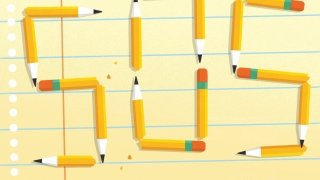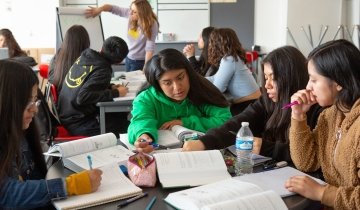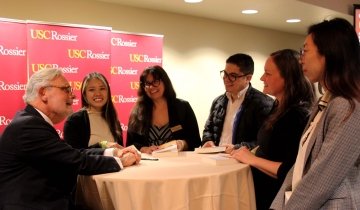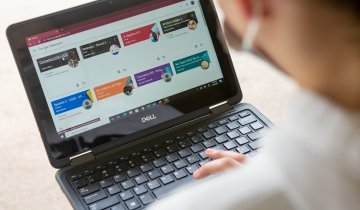Remember when the summer setback or slide among kids was a major concern for educators? Teachers would see a decrease of at least one month’s worth of school-year learning after a three-month summer break. Now imagine that decline after a dramatic shift to online learning and over 14 months of quarantine. Resources are now available to safely bring students back to school, but how do you make up for this much of a disruption in education?
When the National Assessment of Educational Progress (NAEP) released test results in the summer of 2022, the data confirmed what many educators had feared: Math and reading scores of 9-year-olds had dropped to levels that hadn’t been seen in two decades. While the decline in performance was noted across the board, the drop has been greater for Black and Brown students, especially those who lacked access to virtual learning or were enrolled in districts that delayed a return to in-person learning.
“This once-in-a-generation virus upended our country in so many ways—and our students cannot be the ones who sacrifice most now or in the long run,” said U.S. Secretary of Education Miguel Cardona in comments about the NAEP results. “We must treat the task of catching our children up in reading and math with the urgency this moment demands.”
As educators and district leaders wrestle with a host of other challenges, how can they create a plan to get students, especially the most vulnerable, back on track? What research-backed solutions might be most effective in addressing a problem that could have lasting consequences for the schoolchildren affected and our society at large?
More than math and reading
In March 2020, nearly every school in the nation closed and attempted to transition from in-person to online learning. It was a herculean challenge, but surprisingly most schools managed to pull it off relatively well. That’s the good news.
However, many schools stayed closed for more than a year. The bad news that educators are contending with now is that the prolonged isolation has had devastating consequences, both on the mental health of many children and on their academic progress.
The length of time schools were closed was determined by various factors, among them geographic location (rural schools opened more quickly than urban schools); whether or not the school was public, private or a charter school (public schools generally stayed closed longer); the school board’s political leanings; and student demographics. Parents and caregivers found themselves in the precarious situation of responding to the challenges brought on by the pandemic in addition to simultaneously supporting their children academically. The interruption also saw a loss that extended past the academics.
“We learned pretty quickly that remote learning during the pandemic was not as effective as in-person learning,” said Morgan Polikoff, a USC Rossier associate professor of education. “Student achievement fell off in that first year.
Then a lot of schools were still intermittently open, open and closed, or some were really closed through the duration of the 2021 school year.” Polikoff co-authored a report from the Center on Reinventing Public Education (CRPE) in August 2022 which found that learning delays correlated with the amount of time students were out of the classroom or were in a virtual learning environment.
The recently released NAEP results from October 2022 showed that reading and math achievement declined significantly. Reading scores were steadier and only slipped roughly three points for both grade levels compared to 2019.
However, reading scores have slowly been taking a downward dip. On average, math scores for 4th graders decreased five points to the lowest level since 2005, and the average math scores for 8th graders decreased by eight points to the lowest level since 2003. The drop in scores was found to be more significant for Black and Brown students: Math scores declined five points for White students, 13 points for Black students and eight points for Hispanic students.
“We learned pretty quickly that remote learning during the pandemic was not as effective as in-person learning.” —USC Rossier Associate Professor Morgan Polikoff
Polikoff saw that low-income students, Black and Brown students, and White students who were out of school for more time seem to have borne the brunt of the learning loss. Polikoff pointed out Curriculum Associates’ research from 2020. After over two years since those first school closures, the declines are still there. He added: “I think there’s some evidence that we’re starting to close some of those gaps, but we’re certainly still pretty far away, especially in mathematics.”
Patricia Brent-Sanco EdD ’16 is director of equity, access and instructional services at Lynwood Unified School District, located south of Los Angeles. Her district and the community it serves were severely impacted by the pandemic. With 72,000 residents and a demographic of 94% Latino and 4.5% African American, one out of every 400 residents died of COVID-19.
“We are a four-mile city made up of essential workers. Our parents had to go to work,” said Brent-Sanco. “Our students suffered not only grief and possible loss of parents and grandparents and family members, in addition there was a loss in learning.”
The pandemic also exacerbated pre-existing inequalities. A 2021 report by the Department of Education’s Office of Civil Rights confirmed that the pandemic “deepened the impact of disparities to access and opportunity facing many students of color in public schools.” A McKinsey analysis found that an alarming 40% of Black and 30% of Hispanic K–12 students received no online instruction when schools were closed during the pandemic, compared with 10% of White students. Preliminary data indicated that the negative effects of the pandemic fell unevenly with regards to educational opportunities and achievements.
The sobering reports have become a call to action for educators, shedding light on how students of color have experienced a decline in academic achievement. The pandemic compounded and widened structural inequalities. “In other words, students who were struggling in school due to complications of poverty, structural racism, language difference and/or learning difference, among other factors, fell further behind during and after the pandemic,” said Patricia Burch, a USC Rossier professor of education.
For many low-income families, surviving the pandemic with their health and financial well-being intact became more important than how well their children were performing academically. Considering the hardships endured by those who were required to report to work in person, it’s hardly surprising that there is no sense of urgency among many families to address the backward slide in achievement.
According to the Bureau of Labor Statistics, many employees—mainly Black and Brown—worked in person, citing that only 16.2% of Hispanic and 19.7% of Black workers work remotely. And that was before the pandemic. Polikoff says the burden for addressing the problem should not rest on parents or caregivers. “I would say that the system needs to identify students who need the support and provide the support,” he added.
Helpful (or hopeful) solutions: Research and data offer learning loss remedies

Brent-Sanco says that in the Lynwood Unified School District, “the pandemic illuminated what we already knew. We know that there has to be different levels of engagement strategies for those students who face struggles outside of school [and] have environmental factors that they have to deal with when they are outside of our walls.” To address those concerns, Lynwood opened a food bank, distributed computers and wi-fi hotspots, and created a mental health collaborative with a hotline for parents. Other offerings include small-group instructions during the school day, direct instruction and guided and independent practice. In addition, a leadership academy at the elementary and middle schools instructs students on leadership lessons. Several studies have offered evidence-based methods—many overlapping—to mitigate learning loss.
Curriculum Associates conducted a mixed-methods survey with more than 300 schools whose below-level students exceeded expectations. Researchers interviewed those school leaders to understand how they managed to do so during the 2020–2021 school year. Six key practices that were most effective in supporting students emerged from the study: Cultivate educator mindsets to support student success; create a culture of data; prioritize meeting the needs of the whole child (this includes addressing mental health as well as the need for social-emotional learning); create a school environment that engages and inspires students; enhance teacher practice with more resources and support; and strengthen connections with families. A California School Boards Association report from the summer of 2020 offered useful guidelines to address learning interruption echoing similar remedies.
A Learning Policy Institute report, co-authored by USC Rossier Dean Pedro A. Noguera, from May 2021 integrated research on the science of learning and offered six guidelines for educators to address whole-child learning. The research addressed the need for “learning environments that center strong teacher–student relationships, address students’ social and emotional learning, and provide students with opportunities to construct knowledge that builds upon their experiences and social contexts in ways that deepen their academic skills.”
“The biggest mistake schools could make now is to focus narrowly and exclusively on academic achievement,” Noguera said. “They must acknowledge the tremendous social, psychological and emotional challenges that many students and staff experienced, and they must devise strategies to address all of these. This won’t be easy, but it’s the only sensible approach for moving forward.”
What's working?
The research and data reveal the needs that must be addressed. Federal funds have been earmarked to assist schools, and now the question is: How do educators and administrative leaders implement a strategy to address and respond to COVID-19 learning loss? Perhaps the pandemic created a unique opportunity to reimagine how students are taught. Some schools have explored possible options including extending the school day or academic year, summer school and grade retention. The latter, while well-intended, may carry negative consequences. Other options include tutoring, reevaluating curriculum, and teacher professional development.
“High-impact tutoring has emerged as a promising strategy for addressing learning loss,” Burch added. “From years of research, we know that high-quality tutoring can significantly change outcomes for students struggling academically. Tutoring is something that middle- and higher-income families purchase for their children. It needs to be available to all students in public schools. One-on-one or small-group tutoring with highly qualified trained staff, integrated within the school day where possible and focused on literacy and numeracy, is necessary to a functioning public education system. Districts around the country already are spending Elementary and Secondary School Emergency Relief (ESSER) dollars on this. The challenge is how to sustain and, where appropriate, scale efforts once funds dry up.”
A meta-analysis by the National Bureau of Economic Research reviewed studies of tutoring with control groups and showed that it widely increased student achievement and engagement, was shown to be cost-effective and was responsible for significant gains across the board.
Studies have proved that the combination of “high-dosage tutoring,” culturally and linguistically relevant instructions, and the building of relationships with students and parents, delivers significant gains for students. High-dose tutoring is defined as intensive learning in small groups. Consistent, carefully thought-out in-school tutoring has drastically improved learning, according to a February 2021 EdResearch for Recovery report. Brent-Sanco’s Lynwood district offers an additional layer of support to students through mentoring programs, a social emotional curriculum, homework tutoring and support to prepare students for college and a career. “It fills in the gap for anything that students might be missing,” she said.
Secretary Cardona agrees with this approach. “The evidence is clear. High-impact tutoring works, and I’ve urged our nation’s schools to provide every student who is struggling with extended access to an effective tutor,” he said in a U.S. News & World Report story from April 2022.
In addition to tutoring, improving curriculum should be a focus. “Now is the moment to double down on what we know seems to work,” Polikoff said. Through the Understanding America Study (UAS) Education Project—part of the USC Center for Economic and Social Research—he and his team are working with a nationally representative panel of American families regarding the impact of COVID on their educational experiences. The project focuses on collecting data from the subset of UAS households with at least one pre-K–12 child and/or at least one postsecondary student. “I think high-quality curriculum materials will play a very central role in addressing learning loss,” he said. In a March 2022 paper, Polikoff examined how the pandemic affected how curriculum materials were used. Whether in school, online or in a homeschool setting, his recommendations included providing access for all children to quality core curriculum materials, offering personalized curriculum tailored to student abilities and interests, and supporting teachers’ supplemental core curriculum efforts.
“The biggest mistake schools could make now is to focus narrowly and exclusively on academic achievement. They must acknowledge the tremendous social, psychological and emotional challenges that many students and staff experienced, and they must devise strategies to address all of these.” —USC Rossier Dean Pedro A. Noguera
Throughout the pandemic, teachers have been asked to juggle multiple roles, often balancing educator, mental health provider and technology support. Providing them with quality professional development and support is another option to mitigate student learning loss. Polikoff stresses the importance of equipping teachers with the right tools and providing thoughtful solutions, so they can challenge structural barriers.
Before the pandemic, there was a growing concern for student mental and emotional health and the correlation with learning. In April 2022, The New York Times surveyed school counselors on the effect the pandemic had on student mental health. The participants noted that students were not motivated in the classroom and that “emotional health is necessary for learning to happen.” As the value of the whole student increases, so has the role of student counselors. Schools are spending a portion of their COVID relief funds to address student mental support and hiring counselors.
Carol Kemler Buddin BS ’79 is a fourth-grade teacher in the Poway Unified School District in San Diego County. With 41 schools in the district, 60% of the population are students of color and 10% of students are economically disadvantaged.
When everyone returned to the classroom the previous academic year, her district recognized that students were not at the level they should be. “We saw it across the board with all of our students,” she said. For example, in her school’s beginning weeks of kindergarten, when students gain readiness routines, some were not able to write their name, hold a pencil or sit in a group. In the upper grades, some students were not able to regulate their outdoor and indoor volume or were not able to perceive personal space.
“We looked at all the data, and with that data we were able to decide how to best help our students,” Buddin added. The district used COVID funds to focus on student social
and emotional health. To address food insecurity, the district provided free meals to students, and additional counselors were hired for small groups, social emotional lessons and individual student support. Technical and summer training was also provided to educators in the district. Summer school was provided in 2021 and 2022 for students who needed an extended school year for academic instruction.
"Tutoring is something that middle- and higher-income families purchase for their children. It needs to be available to all students in public schools.” —USC Rossier Professor Patricia Burch
In addition, they were able to identify students who needed additional assistance and made recommendations for tutoring. Peer-to-peer tutoring is available three days a week after school, and additional reading teachers were hired for students who needed support. “At the end of the year we just kept saying, We can’t believe what we’ve accomplished,” Buddin said. “At the beginning of the school year, some of our upper-grade students were reading at the second-grade reading level, and we were able to catch them up to their grade level by the end of the school year. We just couldn’t believe it, yet we were joyful about their successes.”
The learning challenges created by the pandemic have provided the opportunity for educators and administrators to reimagine the classroom and reevaluate current educational structures. Buddin said: “We’re all working a lot of hours, and we’re doing a lot of individual instruction right now, because we need to give the kids what they need, and that is what teachers do!”






